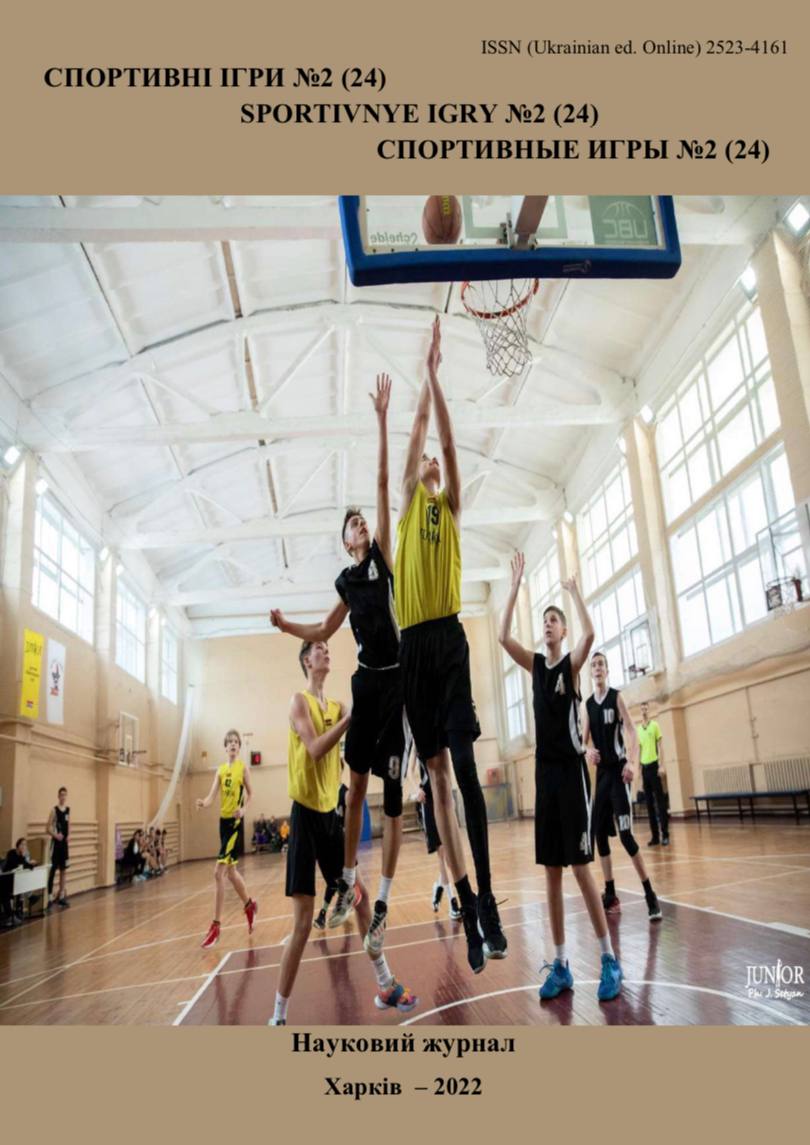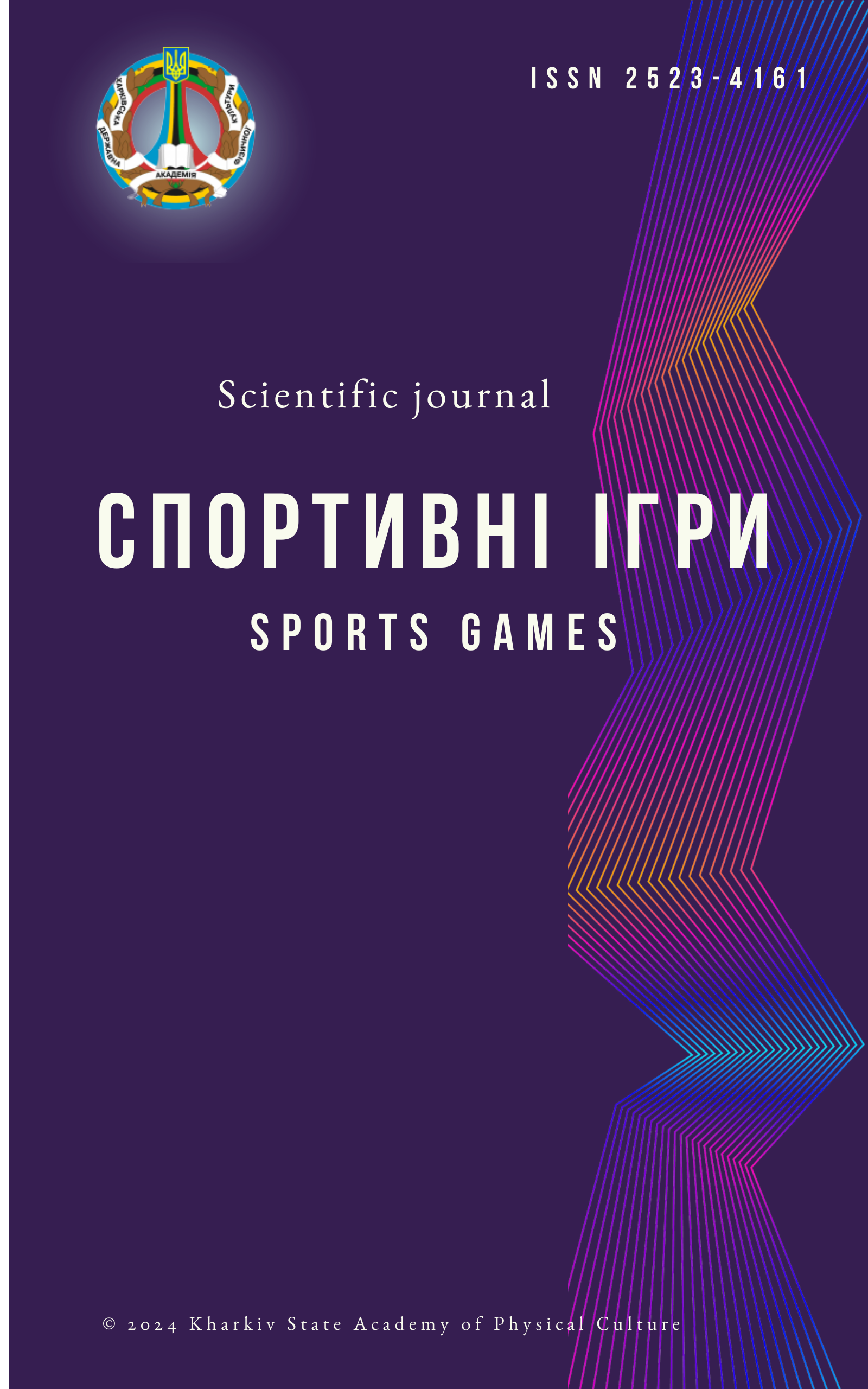The effectiveness of the personal approach to the technical readiness of table tennis athletes
DOI:
https://doi.org/10.15391/si.2022-2.10Keywords:
tennis players, training; exercise machine, temperament, motivation, anxiety, technical readinessAbstract
Purpose - to establish the
degree of effectiveness of the personal approach to the technical readiness of table tennis athletes.
Material and methods. Students of a sports college took part in the study, namely eight players of
different playing style, gender and sports category. The study was carried out for two years (2020-
2021) and took place on the basis of the Kherson professional sports college. To assess the
personality traits of tennis players, G. Eysenck's methodology for determining the type of
temperament, T. Ehlers' method “Motivation for success” and Ch.D. Spielberger's "Personal
Anxiety Self-Assessment Scale". The level of technical readiness of tennis players was determined
by special control tests to assess the number of hits. Results: among tennis players, 62.5% of
extroverts were found. One phlegmatic person was identified by the type of temperament, 25% -
melancholic and 62.5% - choleric tennis players. The majority of tennis players (87.5%) showed an
average level of motivation for success. 50% of tennis players had a high level of personal anxiety,
37.5% had an average level, and only one (12.5%) had a low level of this sign. In the mesocycle for
extroverts, a special "Robot" simulator for table tennis was widely used. In the training mesocycle
for introverts, the BCM exercise (work with a large number of balls) was applied. All table tennis
athletes showed an improvement in the results of technical readiness for all tests in relation to the
program norm. The organization and construction of training sessions taking into account the
personal approach to the technical readiness of table tennis athletes led to the fact that the highest
increase in results was shown by tennis players of different types of temperament. Conclusions:
when organizing sports training, a coach should also take into account the personality traits of an
athlete, since a tennis player can have effective technical readiness, but not always be able to
realize it in training and competitive activities. This is evidenced by the statistically significant relationship between technical readiness and personal anxiety (0.920), as well as between the
motivation for success and the temperament (0.752) of table tennis athletes.
References
Амелін, A.Н. (2002). Сучасний настільний теніс. Київ: Олімпійська література.
Асєєва, Я.Ф., & Шевченко, О.О. (2019). Аналіз результатів анкетування тренерів щодо удосконалення техніко-тактичної підготовленості на етапі попередньої базової підготовки в тенісі настільному. Спортивные игры, 3 (13), 4-11. doi: 10.15391/si.2019-3.01
Байгулов, Ю.П. (2010). Настольный теннис: вчера, сегодня, завтра. Москва: Физкультура и спорт, 156
Ильин, Е.П. (2010). Психология спорта. СПб: Питер.
Родионов А.В. (2004). Психология физического воспитания и спорта. Москва: Академический Проект.
Синицина, Ю., Шалар, О., & Стрикаленко, Є. (2020). Методика особистісно орієнтованого підходу до спортсменів з настільного тенісу. Тенденції та перспективи розвитку науки і освіти в умовах глобалізації, 64, 380-383
Темченко, В.А., Ковтун, Е.В., & Тимченко, А.Н. (2020). Исследование физической подготовленности девушек, занимающихся настольным теннисом в процессе спортивно-ориентированного физического воспитания. Спортивні ігри, 2(16), 69-75. doi: 10.15391/si.2020-2.07
Уэйнберг, Р.С., & Гоулд, Д. (1998). Основы психологии спорта и физической культуры. Київ: Олимпийская литература, 335
Шалар, О.Г., Стрикаленко, Е.А., & Иващенко, А.В. (2013). Индивидуальные свойства личности как критерий выбора стиля игры теннисисток. Физическое воспитание студентов, 2, 69-73.
Шалар, О., Жосан, І., Шум, Д., & Стрикаленко, Є. (2014) Властивості темпераменту і волі гандболісток різного ігрового амплуа. Спортивний вісник Придніпров’я, 3, 40-43.
Шалар, О.Г, Гузар, В.М., & Пушкіна, Л.Й. (2015). Особливості емоційно-вольової сфери легкоатлетів-бігунів. Вісник Чернігівського національного педагогічного університету імені Т.Г. Шевченка, 129, IV, 48-51.
Шевченко, О.О., Паєвський, В.В. (2019). Зміна показників спеціальної фізичної підготовленості та фізичного розвитку дівчат 11- 12 років в тенісі настільному.
Спортивные игры, 2(12), 71-78. https://doi.org/10.5281/zenodo.2544965
Strykalenko Yevgeniy, Zhosan Ihor, Shalar Oleh. (2017). Intellectual abilities high-end handball players of different playing roles. Фізичне виховання, спорт і культура здоров’я усучасному суспільстві, 4(40), 128-133.
Nikolakakis A., Mavridis G., & Gourgoulis V., Pilianidis T., Rokka S. (2020). Effect of an intervention program that uses elastic bands on the improvement of the forehand topspin stroke in young table tennis athletes. Journal of Physical Education and Sport (JPES), 20 (Supplement issue 3), 2189-2195. DOI:10.7752/jpes.2020.s3294
Baidiuk M., Koshura A., & Kurnyshev Yu., Vaskan I., Chubatenko S., Gorodynskyi S., Yarmak O. (2019). The influence of table tennis training on the physical condition of schoolchildren aged 13-14 years. Journal of Physical Education and Sport (JPES), Vol 19 (Supplement issue 2), 495-499, DOI:10.7752/jpes.2019.s2072
González-García, H., Pelegrín, A., & Trinidad, A. (2020). Differences in anger depending on sport performance in table tennis players. Journal of Human Sport and Exercise, 15(1), 177-185. doi:https://doi.org/10.14198/jhse.2020.151.16
Shalar Oleh, Strykalenko Yevhenii, Huzar Viktor, & Homenko Yladislav, Popovich Tatyna. (2019). Psychological readiness of handball players for the competition. Sport science international scientific journal of kinesiology, 12, іssue 1, 95-102.
Shalar, O., Huzar, V., Strykalenko,Y., Yuskiv, S., Homenko, V., & Novokshanova, A. (2019). Psycho-pedagogical aspects of interaction between personality traits and physical qualities of the young gymnasts of the variety and circus studio. Journal of Physical Education and Sport (JPES), 19 (Supplement issue 6), 2283-2288.
http://dx.doi.org/10.7752/jpes.2019.s6344
Strykalenko, Y., Shalar, O., Huzar, V., Voloshynov, S., Yuskiv, S., Silvestrova, H., & Holenko, N. (2020). The correlation between intelligence and competitive activities of elite female handball players. Journal of Physical Education and Sport (JPES), 20 (1), 63-70. http://dx.doi.org/10.7752/jpes.2020.01008
Strykalenko,Y., Shalar, O., Huzar, V., Andrieieva, R., Zhosan, I., & Bazylyev,S. (2019). Influence of the maximum force indicators on the efficiency of passing the distance in academic rowing. Journal of Physical Education and Sport (JPES), 19 (3), 1507-1512. http://dx.doi.org/10.7752/jpes.2019.03218
Strykalenko,Y., Shalar, O., Huzar, V., Voloshynov, S., Homenko, V., & Bazylyev, S. (2020). Efficient passage of competitive distances in academic rowing by taking into account the maximum strength indicators. Journal of Physical Education and Sport (JPES), 20 (6), 3512-3520. http://dx.doi.org/10.7752/jpes.2020.06474
Strykalenko,Y., Huzar, V., Shalar, O., Voloshynov, S., Homenko, V., & Svirida, V. (2021). Physical fitness assessment of young football players using an integrated approach. Journal of Physical Education and S













